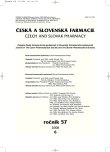Testing the effect of 2’, 3, 4’-trihydroxychalcone in experimental diabetes mellitus: a pilot study
Authors:
L. Bartošíková 1; J. Nečas 1; T. Bartošík 2; M. Pavlík 2
Authors‘ workplace:
Univerzita Palackého Olomouc, Lékařská fakulta, Ústav fyziologie
1; Fakultní nemocnice U svaté Anny v Brně, Anesteziologicko-resuscitační klinika
2
Published in:
Čes. slov. Farm., 2008; 57, 249-253
Category:
Original Articles
Overview
The effect of 2’, 3, 4’ - trihydroxychalcone was monitored in the experimental conditions of alloxan-induced diabetes mellitus. The animals were divided by random selection into 2 groups (n = 7). The treated group was given chalcone in doses of 10 mg/kg in Avicel, the placebo group was given only a solution of Avicel. The last group was intact. Selected laboratory parameters (glucose, urea, cholesterol, antioxidative enzymes, total antioxidative capacity, malondialdehyde in serum; diuresis, total glucose and protein losses through urine) were determined. Kidney tissue and pancreas samples were taken for histopathological analysis. The results revealed a statistically significant decrease (p ≤ 0.01) in blood glucose level, a significant increase (p ≤ 0.01) in glutathione peroxidase, total antioxidative capacity (p ≤ 0.01) and a significant decrease (p ≤ 0.01) in the malondialdehyde level in the treated group compared to the placebo group. A highly significant decrease (p ≤ 0.01) in diuresis, glucose and protein losses through ureine was identified in the treated group compared to the placebo group. The superoxide dismutase catalytic activity, urea and cholesterol levels involved non-significant changes. The results of biochemical examination show a protective antioxidative and antihyperglycemic effect of tested chalcone. The results of histopathological examination correlate with them only partially.
Key words:
chalcones – diabetes mellitus – antioxidants
Sources
1. Saltiel, A. R., Kahn, R.: Nature, 2001; 414, 799–806.
2. Zimmet, P., Alberti, K. G. M., Shaw, J.: Nature, 2001; 414, 782–787.
3. Ginsberg, H., Plutzky, J., Sobel E.: J. Cardiovasc. Risk, 1999; 6, 337.
4. Wolff, S. P.: British Med. Bull., 1993; 49(3), 642–652.
5. Tang, L., Wei, W., Chen, L., Liu, S.: J. Ethnopharmacol., 2006; 108, 109–115.
6. Zanatta, L., de Sousa, E., Cazarolli, L. H. et al.: J. Ethnopharmacol., 2007; 109, 151–155.
7. Malaisse, W. J.: Biochem. Pharmacol., 1982; 22, 3527–3534.
8. Kosugy, H., Kikugava, K.: Free Rad. Biol. Med., 1989; 7, 205–207.
9. Enoki, T., Ohniti, H., Nagamine, K. et al.: J. Agricult. Food Chem., 2007; 55, 6013–6017.
10. Sharma, S. B., Nasir, A., Prabhu, K. M., Murthy, P. S.: J. Ethnopharmacol., 2006; 104, 367–373.
11. Sinclair, A. J.: Diabet. Rev., 1993; 2, 7–11.
12. Giugliano, D., Ceriello, A., Paoliso, G.: Diabet, Care, 1996; 19, 257–267.
13. Packer, L., Witt, E. H., Tritschler, H. J.: Biol. Med., 1995; 19, 227–250.
14. Wohaieb, S. A., Godin, D. V.: Diabetes, 1987; 36, 1014–1018.
15. Roy, S., Seghal, R., Padhy, B. M., Kumar, V. L.: J. Ethnopharmacol., 2005; 102, 470–473.
17. Anděl, M. et al.: Diabetes mellitus. 1. vyd. Praha: Galen, 2001, s. 78.
18. Indyah, S. A., Timmerman, H., Samhoedi, M. et al.: Eur. J. Med. Chem., 2000; 35, 449.
19. Chen, M., Christensen, S. B., Zhai, L. et al.: J. Infect. Dis., 1997; 176, 1327.
20. Nielsen, S. F., Christensen, S. B., Cruciani, G. et al.: J. Med. Chem., 1998; 41, 4819.
21. Hsin-Kaw, H., Tai-Hua, L., PyanWang, J. et al.: Pharma Res., 1998; 15, 39.
22. Kumar, S. H., Hager, E., Catherine, P. et al.: J. Med. Chem., 2003; 46, 2813.
23. Satyanarayana, M., Tiwari, P., Tripathi, B K. et al.: Bioorg. Med. Chem., 2004; 12, 883–889.
24. Shukla, P., Singh, A. B., Srivastava, A. K., Pratap, R.: Bioorg. Med. Chem., 2007; 17, 799–802.
25. Rastelli, G., Antolini, L., Benvenuti, S., Constantino, L.: Bioorg. Med. Chem., 2000; 8, 1151–1158.
26. Nozawa, H.: Biochem. Biophys. Res. Commun., 2005; 336, 754–761.
Labels
Pharmacy Clinical pharmacologyArticle was published in
Czech and Slovak Pharmacy

2008 Issue 6
Most read in this issue
- Possible effects on the liberation of alaptid from dermal semisolid preparations
- Studies of local anesthetics Part 185: Thermodynamic parameters of heptacainium chloride in the solution of NaBr
- Optimization of the extraction method for the determination of methadone and its metabolite EDDP in urine by gas chromatography
- The effect of lipophilic carrier concentration on hydrophilic-lipophilic matrix systems characteristics
